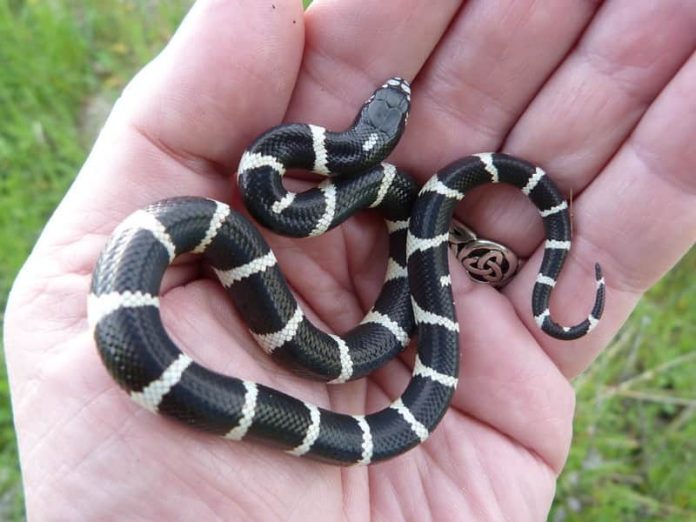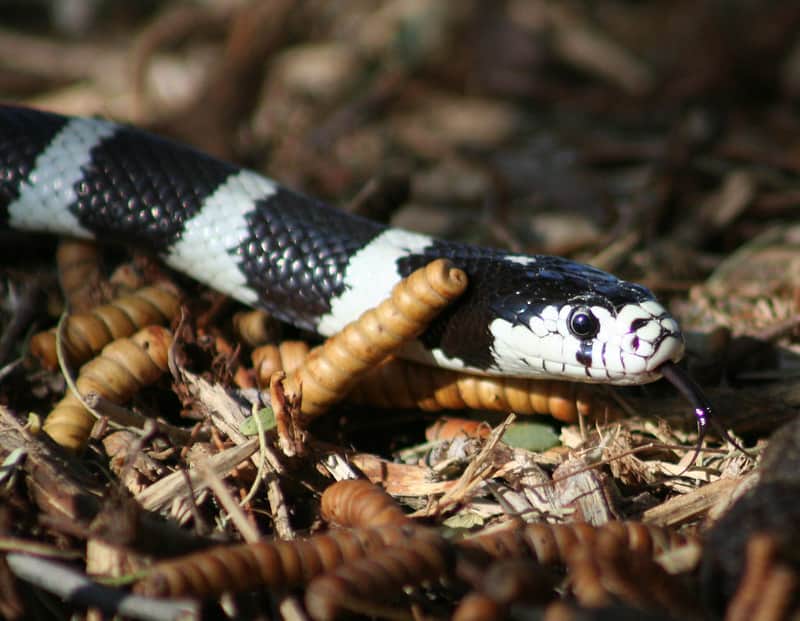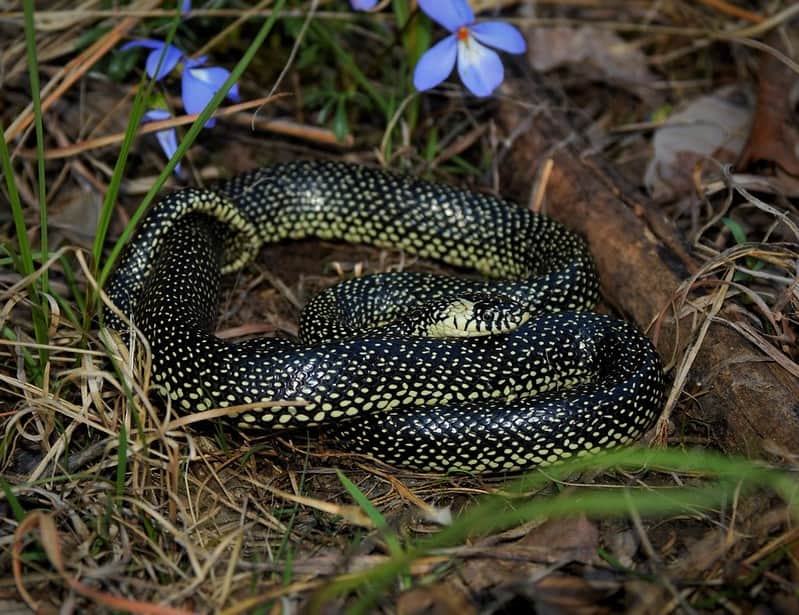
Snakes are truly fascinating creatures coming in multiple shapes, sizes, and patterns. Although they can be pretty scary at times, it would be an understatement to say that they are one of the valuable parts of the ecosystem.
With so many colors and patterns to talk about, let us today focus on the monochrome. Classic vibes, yes?
Snakes with Black and White Stripes:
Below are the 5 snakes we sifted through our search that have black and white stripes on their body.
Garter Snake

Garter Snakes have quite a diversity in terms of appearance, mainly color and patterns. Their bodies with variable coloration including black, brown, gray, and olive background, typically have three light stripes. These stripes run along the length of their body.
These light strips can have different colors like white, yellow, blue, greenish, or brown and in some rare cases, these stripes are absent or poorly defined. They comparatively have a wider head than their neck which is uniformly dark-colored.
Garter Snakes have red-colored tongues which are tipped in black. Their chin, throat, and belly significantly resemble stripes in coloration including white to yellow, greenish, blue, or brown.
The range body length of a garter snake is between 46-137 cm in total and their average length is 88cm. Their average body weight is around 150g. The life expectancy is 4-5 years in the wild and 10-20years in captivity.
Most of the species of garter snake do not have venomous neurotoxin. The bite of the species (those who have the venom), causes only irritation and swelling of the area around the puncture wound. Allergic reactions to their venom are very rare, but if someone is experiencing symptoms like hives, nausea, vomiting, and dizziness they should immediately seek medical aid.
Garter Snakes are highly adaptable, and they can survive in a huge variety of habitats. Yes, and by that, we mean, almost anywhere such as meadows, marshes, woodlands, and hillsides, where they get moist and grassy environments. They can also be found living near water bodies like the edges of ponds, lakes, ditches, and streams; they are more common in suburban and urban areas.
Garter Snake’s diet comprises earthworms, leeches, slug, snails, crayfish, and other small fishes and snakes. Garters aren’t picky eaters and feed on a variety of animals such as small mammals, lizards, and even young birds that can’t fly too high.
They are found throughout North America. Garter Snakes are fairly distributed in the subarctic plains of Canada and Costa Rica.
California King Snake

California King Snake has a slender, cylindrical body that is patterned with a black, white, and red band. The red bands on their bodies are bordered with black bands on both sides. Their head is white colored with blacktop and some black scales on either side.
The black and red bands are speckled with black marks posteriorly in general and these bands are extended onto the white venter and their scales are smooth and shiny. Sometimes the young ones and even the adults can be seen turning jet black, with no trace of patterns.
They are medium-sized snakes who reach a body length of 122cm, while most of them are shorter than 100cm long. Their average body weight is 200g-225g, and their lifespan in the wild is 2-6 years, 10-20 years in captivity.
California King Snake is a non-venomous snake, they kill their prey with their teeth by biting them around the head and they subdue them by constricting their body around them. They do bite humans, but their bite doesn’t cause any serious health issues and the bite is similar to a mosquito bite.
California King Snake can be found in a variety of habitats including woodlands, grasslands, deserts, marshes, suburban, and places with ample rocks, rotting logs where sufficient sunlight is available. Their diet consists of mice, lizards, small birds, and snakes.
They aren’t picky eaters, and they can live their whole life eating mice only.
They are found throughout the West Coast of North America and many of them also live in Oregon, California, Utah, and Arizona.
Gopher Snake

Gopher Snakes have a wider and larger head with narrow necks and large eyes unlike the species of snakes of their size. They have brown to black blotches marked on their lighter straw to gray-colored bodies. Their color patterns are dependent on the dominant cover vegetation in a region and their color patterns vary regionally.
The individuals who belong to the wild population, have stripes, blotches, and even albino. There are dark spots on their white to the yellowish ventral surface. And they have a dark line across their face in front of the eyes.
Their average body length is 180-275cm, they weigh around 2-4 pounds and their lifespan in the wild is 12-15 years and in captivity, they can live for 33 years.
Although Gopher Snakes have an intimidating appearance, they aren’t dangerous and they are not even venomous. They are docile creatures, but they bite when they are threatened and their bite can inflict a painful bite.
Gopher Snakes inhabit different types of habitats like arid deserts, coastal dunes, grasslands, coniferous forests, including places with burrows, dense vegetation, and urban areas like parks, gardens, and suburban areas. Their diet typically consists of birds, lizards, small snakes and mammals, insects, rodents, and eggs. They are found in Northern Mexico, Missouri, Illinois, Oklahoma, and western Texas.
Queen Snake

The coloration of a Queen Snake varies from olive to gray to dark brown with peach or yellow stripes. Their stripes run down to their length at the first scale row and there are also prominent ventral stripes of a darker color running down to the length of its belly which is a significant feature to identify them.
The juvenile and young ones have three extra stripes which tend to fade away as they mature. The shape of their head is narrow with scales on the top and cream to the yellow-colored belly.
This slender species of snake grows to a maximum of 24 inches, the minimum being 15 inches. These creatures have an average life expectancy of 19 years.
This species is a non-venomous, semi-aquatic species of snake, there is a very little chance of getting bites from them and their bite is harmful to humans.
They are typically found near shallow waters like rivers, streams, lakes, ponds, marshes, canals, in niches of bedrock, and they can be found sunning themselves on rocks, branches, and logs near water.
Their diet mainly consists of crayfish in particular but they also feed on raccoons, otters, hawks, frogs, and herons. Usually found in temperate regions, Gophers can be found in America, and Florida (of course). This species can also be found in Alabama and in the southwestern parts of Ontario.
Ribbon Snake

Ribbon Snakes have a slim and striped body with their tails relatively longer than their body length. They have three stripes on their body and these stripes are white, yellow, or greenish colored running along their body length on a black or dark brown background. And their stripes help them to hide in the grassy habitats.
With bordered eyes with light bars, these ribbon snakes are truly mesmerizing. Their belly is white or yellow-colored. Their average body length is 45-86cm, and their lifespan in the wild is 3-6 years and 12-20 years in captivity.
The Ribbon Snakes are non-venomous, and they aren’t dangerous to humans and even the kids. Docile in nature, Ribbon Snakes only attack upon intimidation.
Inhabiting aquatic areas with high vegetation such as marshes, ponds, streams, and lakes, Ribbon Snakes can be found basking on rocks, drier areas, or flat vegetation. They feed on fishes, worms, snails, eggs and they can rarely be found feeding on small mammals. They are found in Florida, Ontario, and in America.
Black Snakes with White Stripes
Below are the snakes that have a predominantly black body characterized by white stripes.
Eastern Kingsnake

Eastern Kingsnakes are one of the largest snakes with a body length of 36-48 in and a shiny black body. Their smooth scaled body has white or yellow chain-link bands throughout. These bands cross each other and connect along the sides. Their heads are short and stout with beady small eyes. The body weight may vary between 0.25-2.2 kg, and their average lifespan in the wild is up to 10 years and 15-25 years in captivity.
It is a non-venomous, constrictor species of snake, immune to many venomous snakes and they feed on them. The bite of Eastern Kingsnake isn’t harmful to humans and it can be treated by washing wounds with soap and water and applying peroxide.
These snakes mainly inhabit hardwood and pine forests, tidal wetlands, and suburban areas. Their diet consists of lizards, birds, snakes, rodents, and turtle eggs. They are found in the United States, and all over Georgia and South Carolina.
Bandy Bandy

Bandy Bandy is a small-sized snake species with a smooth scaled body. Their glossy skin has black and white rings that cover their whole body including their head. They have small eyes and a slender, cylindrical body. They have a small, rounded black snout, with a small and blunt tail. The average body length is 50-80cm.
They are venomous, but their venom is not strong enough to kill a human. A bite, however, requires medical attention.
They inhabit a wide range of habitats including coastal forests, woodlands, open scrub, and outback desert. They feed on blind snakes and eggs of other small snakes. Bandy Bandy snakes are usually seen in Australia and are densely populated in Malayalam.
White Snakes with Black Spots
Eastern Massasauga Rattlesnake

The Eastern Massasaugas are medium-sized snakes with an average body length of 18-30 inches. Their general appearance varies from having brown blotches on a gray body to a completely black color body. The Cryptic patterns and the coloration helps them to camouflage in vegetation, rocks, leaves, and shadows, making them undetectable even at close range. Their average body weight is 11-15 ounces and their lifespan is mostly around 20 years.
Due to their shy behavior, they don’t usually bite people. Their bite is known to be painful and also potentially life-threatening. Though their venom is more toxic than the other rattlesnakes, they are able to inject only a small amount of their venom. The venom is not enough to kill a person and with antivenom treatment, the fatalities can be overcome.
They tend to inhabit wetland areas, including marshy grasslands, lake edges, woodlands, and swamplands. Here they mostly feed on lizards, birds, frogs, mice, and even on other small snakes. They are found in Ontario, Northern Mexico, and the United States.
Sidewinder

Sidewinders are named so because of their unique side-stepping locomotion which they use to move across the loosely packed desert sands. They have small horns on top of their eyes; they are short and stout snakes with broadheads.
The coloration resembles the type of desert sand of their environment. Sidewinders can be found in shades of tan, pink, orange, and gray with dark spots on their back. They grow up to 17-32 in length, they weigh around 100-400g on average and they live for 13-20 years.
The small size of their venom gland and weaker venom makes them less dangerous than the other rattlesnakes. Although that doesn’t make them any less dangerous. If bitten, one should immediately seek medical attention.
They inhabit areas that are very sandy, like sandy washes, sand dunes, and warm deserts. Their diet consists of mainly rodents and lizards, mice, and kangaroo rats. They are found mostly in the deserts of North America, Africa, the U.S., Arabia, and Mexico.
Black Snake with White Spots
Black Speckled Kingsnake

Black Speckled Kingsnake is a large snake, which has a smooth scaled body. The black-colored body has irregular white to yellow markings on it which vary in sizes and shapes, giving it a speckled appearance. Their belly is mostly black with irregular cream or yellow colored markings. The average body length of the adults is 36-48 inches. Their average lifespan is around 10-20 years.
These constrictors are cannibalistic and have the capacity to eat even the most lethal of snakes including the pit vipers. They are nonvenomous but they do bite if handled carelessly or harassed. The bite however doesn’t cause any serious health hazards.
They generally inhabit brushy areas, forest edges, edges of swamps and marshes, they can also be encountered on rocky and wooded hillsides. A black speckled kingsnake’s diet consists of small mammals, birds, frogs, and other snakes (aforementioned). The black speckled kingsnakes are a common sight in the U.S. and Ohio. They are generously populated in Virginia, Alabama, and Ohio too.
Black Snakes with White Belly
Black Rat Snake

A Black Rat Snake has a black-colored body with a white or creamy yellow colored chin and throat. The mixture of light and dark color on their belly gives them a mottled appearance. The light colors are mainly apparent between the weakly keeled scales at their back.
Their young ones are generally gray colored with light spots which run down from the middle of the back, and they have white-colored eyes whereas the adults have black-colored eyes. They are large snake species with an average length between 106-185 cm. Their body weight can be up to 0.5-2.2 kg.
Black Rat Snakes have an average lifespan in the wild of 10-15 years. Black Rat Snakes are also usually held captive and they live longer in captivity up to 30 years owing to better care and less harsh environmental conditions.
Black Rat Snakes are not venomous snakes – they have sharp teeth to bite their prey and to suffocate them by constriction of their own body around the prey. They are docile creatures, and they bite only when they feel threatened.
So do not try to annoy one!
Though they are not venomous, their bite can be very painful and it causes acute discomfort within minutes, and you should immediately visit a hospital.
Black Rat Snake inhabit a wide variety of habitats including rocky hills, dense forests, flat farmland, suburban, and woodlands. Being semi-arboreal in nature, they climb on trees to shelter in hollow cavities and also for searching for food.
They can be found in abandoned buildings, trash piles, and the rafters of buildings hunting for rodents. They can be found throughout the eastern United States, and also in North America, Europe, and Asia.
White-bellied mangrove snake
Mangrove Snake is a slender snake with a black-colored body and a white to yellowish-colored belly. They have yellow scales around their face and bands around their body. Their head is broad with a slender to moderate stout. Their small eyes have elliptical pupils. The average body length is 2.5 meters, and they generally have a lifespan of 17-20 years.
They are mildly venomous, they use the toxins in their venom to paralyze their prey. The venom is not harmful to humans but it is capable of causing tremendous pain, swelling, and redness of the skin.
They inhabit mainly mangrove forests, and lowland forests with ample vegetation and a variety of prey to feed on. Their diet consists of small mammals they can swallow, small to medium-sized birds, lizards, and frogs. They are found throughout Malaysia, Indonesia, Singapore, Thailand, and the Philippines. These nasty snakes can also be found in Texas.
Sources
- Garter snake, Wikipedia
- Is That Snake Venomous?, Treehugger
- What Kind of Snake is That?, Callnorthwest






